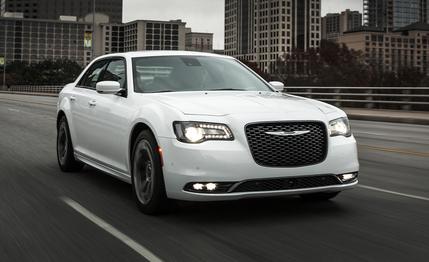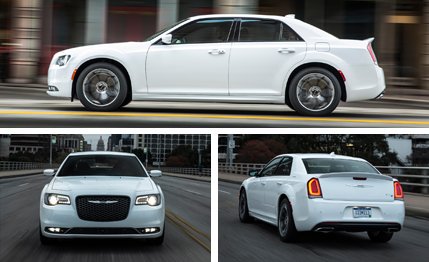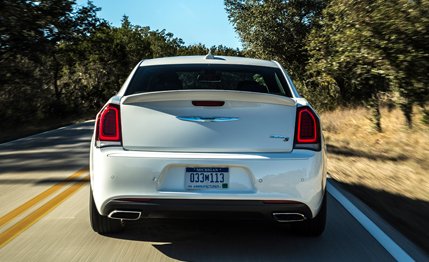
 First Drive Review
First Drive Review
Quick! Name an American, rear-drive, V-8–powered, full-size sedan. If you said, “Chrysler 300,” you’re only 15 percent right, because that’s the proportion of 300 buyers who actually opt for the V-8. The rest decide that the V-6 will suffice, a strong indicator that while the model name may be rooted in a high-performance heritage, the car sells mostly on its styling, size, and value. All the same, the V-8 is key to the car’s image so that’s the version we sought out first—in both the 300C and sportier 300S trims—to sample on roads in and around Austin, Texas.
A decade after Ralph Gilles’s design for the 2005 model caused an industry sensation, the 300 has been revamped a second time, with new nose and tail treatments featuring redesigned lights and a 32-percent larger grille, a fresh interior, and an eight-speed automatic operated by a rotary dial on the console. The EPA combined fuel-economy rating goes up 1 mpg to 19 (16/25 mpg city/highway) with the new transmission, the quicker shifting of which Chrysler says will also improve performance even though the engine is unchanged.


The 300 got a thorough redo in 2011, but for 2015 it gets no new sheetmetal, unlike its platform-mate, the Dodge Charger. It does add another trim level, the 300C Platinum. The C, S, and C Platinum all offer the V-8 as an option but the engine is not available on the base Limited, adding a perhaps-unintended layer of meaning to that version’s name.
Checking the option box for the 5.7-liter V-8 costs $3000, which gets you not only the 363-hp Hemi, but also bigger brakes (with dual- rather than single-piston calipers up front and ventilated rather than solid rotors in back) and a 160-mph speedometer. The 300S also gains a decklid spoiler, while C and Platinum trim levels get the paddle shifters that come standard on any S. This year, the V-8 can no longer be paired with all-wheel drive, owing to that combo’s abysmal take rate; evidently, people who already commit $2500 extra for AWD are disinclined to throw another three grand at the lump under the hood.
Brand president and CEO Al Gardner’s marching orders for Chrysler are to square up more directly against the industry’s volume-sales leaders, including Ford, Chevrolet, and Toyota. As Chrysler’s flagship, the 300 still has some near-luxury pretensions, but the sharpened focus gives Dodge precedence as the “performance” brand. This goes some way toward explaining the lack of a U.S.-market SRT8 version. The SRT8 will survive in some foreign markets, but its price point exceeds (and its sales volumes fall far short of) Chrysler’s targets for North America.


A pity perhaps, but mainstream buyers in search of a V-8’s bellowing torque still have the 5.7-liter and its 394 lb-ft to lust after. New mechanical elements are the eight-speed gearbox, electric-assist power steering, and a retuned suspension using aluminum components. Aside from the rotary-dial gear selector much like the one on the Chrysler 200, prominent changes inside include a handsome new steering wheel, a new instrument cluster, and a redesigned center stack. There’s a good division of labor between the 8.4-inch UConnect touch screen and the button interfaces, although we grew frustrated by a radio we couldn’t turn off—the volume can be muted, but it repeatedly reactivated itself without our bidding. Also, the heated-seat controls are buried in the touch-screen menu rather than given dedicated buttons; partially offsetting that annoyance, a seat-heat icon appears on-screen when you first start the car, so you can avoid the irritation if you’re quick.
Supplementing that screen is a new 7.0-inch driver-information display nestled between the tach and speedometer. As long as you’re okay with the dial-a-gear setup, the controls are all easier to figure out and use than in the previous model, even with the added indicators and buttons for the new electronic driver aids, which include adaptive cruise control with full-stop ability, lane-departure warning, lane-keeping assist, forward-collision warning, and brake assist. These are contained in the SafetyTec 2 package, a $1695 option; SafetyTec 1, also at $1695 and required to get SafetyTec 2, brings parking assist, blind-spot and cross-traffic alerts, as well as forward-collision and adaptive cruise.